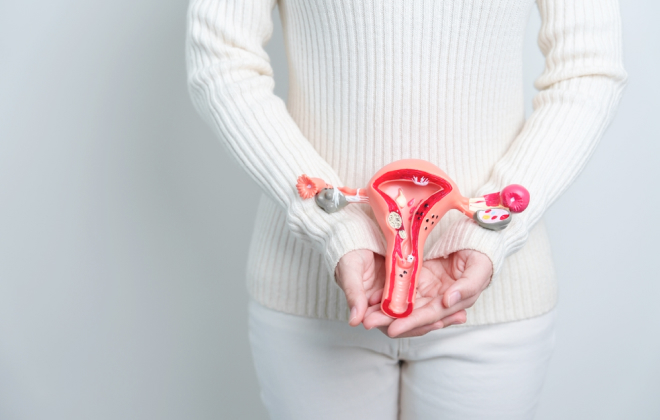


Spotting is a common yet often confusing occurrence for many individuals. It refers to light bleeding that happens outside of your regular menstrual cycle. While it can be completely normal, it may also be a sign of underlying health conditions. Most women experience spotting at some point in their life.
In this comprehensive guide, we’ll explore spotting and what it can indicate about your reproductive health.
Spotting refers to light bleeding that occurs between periods. Unlike a regular period, which usually involves a heavier flow and lasts several days, spotting is typically much lighter and may only last for a short time.
Spotting symptoms can vary from person to person, but some common ones include:
A period occurs when the uterus sheds its lining due to the absence of pregnancy. The process is controlled by hormones such as oestrogen and progesterone, which regulate ovulation and menstruation.
One of the biggest causes of confusion is distinguishing between spotting and a period. The difference is important because it helps in understanding menstrual health and identifying potential concerns.
| Feature | Pregnancy Spotting | Period |
|---|---|---|
| Flow | Very light | Moderate to heavy |
| Colour | Pink, brown or red | Bright red or dark red |
| Duration | A few hours to a couple of days | 3-7 days |
| Frequency | Occurs unpredictably between cycles | Comes at regular intervals |
| Accompanied by cramps? | Sometimes mild | Usually moderate to severe |
One might experience spotting due to several reasons. Some are harmless, while others require medical attention.
Spotting before your period is often caused by minor hormonal fluctuations but can sometimes indicate underlying conditions such as:
Spotting in pregnancy is common, especially in the first trimester. However, it can sometimes be a cause for concern.
Spotting but no period can be puzzling, and it may be due to various reasons:
Spotting is usually harmless, but persistent or abnormal spotting should be checked by a doctor as it may signal serious health problems. If not treated, spotting can lead to complications.
Frequent or prolonged spotting can lead to low iron levels, causing fatigue, dizziness, weakness, and pale skin. Severe anaemia can impact overall health and may require iron supplements or dietary adjustments.
Spotting due to irregular hormone levels (oestrogen and progesterone) can cause further disruptions in menstrual cycles, leading to infertility, mood swings, and metabolic disorders. Untreated hormonal imbalances, such as those seen in PCOS or thyroid disorders, can lead to weight gain, acne, and excessive hair growth.
Spotting during pregnancy could indicate a serious ectopic pregnancy or miscarriage risk, which may require medical attention. Placental issues such as placenta previa or placental abruption could also cause spotting and pose risks to both the foetus and the mother.
Untreated infections (e.g., chlamydia, gonorrhoea, bacterial vaginosis) can spread to the fallopian tubes and uterus, causing PID. PID can lead to chronic pelvic pain, infertility, and increased risk of ectopic pregnancy.
Abnormal spotting, pain, abnormal discharge, or bleeding after menopause may be early signs of cervical cancer. Excessive thickening of the uterine lining can lead to endometrial cancer if left untreated.
Persistent spotting caused by PCOS, fibroids, or ovulation issues can interfere with conception. Chronic irregular spotting can make it difficult to track ovulation, affecting family planning efforts.
Some cases of spotting eventually progress into prolonged heavy bleeding, requiring hormonal treatments or surgery to manage.
Early signs of pregnancy can sometimes be mistaken for a light period. Hence, it is most essential to distinguish between pregnancy spotting and a regular period.
| Feature | Pregnancy Spotting | Period |
|---|---|---|
| Colour | Pink, brown or red | Bright red or dark red |
| Flow | Light, only a few drops or streaks | Moderate to heavy bleeding |
| Duration | A few hours to 2 days | 3-7 days |
| Timing | 6-12 days after ovulation (before the expected period) | Regular cycle (every 21-35 days) |
| Accompanied By | Mild cramps, nausea, fatigue, tender breasts | Stronger cramps, lower back pain, PMS symptoms |
| Absorbency Needs | Usually doesn’t require a pad or tampon | Requires pads, tampons, or menstrual cups |
If spotting is frequent, unpredictable, or occurs for an extended period without a clear cause, it is important to see a doctor. Seek medical attention if spotting is accompanied by severe pain, dizziness, fever, or unusual discharge, as these could indicate an infection or other underlying condition. Postmenopausal spotting should always be evaluated, as it may signal a more serious issue.
Additionally, if you experience heavy spotting that disrupts daily activities, occurs after intercourse, or is associated with irregular periods, hormonal imbalances, or pregnancy concerns, consulting a healthcare provider is essential to rule out any medical conditions and receive appropriate care.
Diagnosing spotting involves a detailed evaluation by a healthcare professional to determine the underlying cause. Since spotting can result from various factors, doctors use a combination of medical history, physical exams, and diagnostic tests.
A physical and pelvic exam helps check for abnormalities in the reproductive system, such as infections, cervical issues, or growths like fibroids or polyps.
Spotting is often harmless but can also be disruptive or concerning. Proper management involves identifying the cause and taking appropriate steps to regulate it. Here are a few ways you can manage spotting effectively:
Keeping a record of spotting episodes can help identify patterns and triggers. Use a period tracking app or journal to note the date, duration, colour, and flow of spotting. Track additional symptoms such as cramps, stress levels, birth control usage, or recent lifestyle changes. Identify if spotting occurs around ovulation, after, or before/after your period.
Certain lifestyle factors, such as diet and nutrition, exercise, and stress management, can contribute to hormonal imbalances and irregular spotting. To prevent anaemia from excessive spotting, it is recommended to eat iron-rich foods such as spinach and red meat, increase vitamin C intake for vessel health, including healthy fats such as avocados and nuts for hormonal balance, and stay hydrated. Engaging in moderate exercise such as walking or yoga, avoiding over-exercising, and managing stress through techniques like meditation can also help maintain hormonal balance.
Hormonal contraceptives like pills, IUDs, implants, and patches can cause spotting. If spotting happens when starting a new birth control, wait 2-3 months for your body to adjust. If spotting persists after that, see a doctor to adjust the dosage or try a different method. Missing pills or not using birth control consistently can lead to breakthrough bleeding. Be sure to take your birth control consistently to prevent this.
If spotting is mild but persistent, taking non-steroidal anti-inflammatory drugs (NSAIDs) such as ibuprofen may help reduce bleeding. Panty liners can help manage unexpected spotting and keep you comfortable throughout the day.
If spotting is frequent, heavy, or accompanied by other symptoms, consult a doctor. They may recommend:
By monitoring symptoms and making lifestyle adjustments, you can effectively manage spotting and maintain better reproductive health.

Spotting can be a completely normal part of a woman’s reproductive health, but it’s important to recognise when it might signal an underlying issue. Understanding the difference between spotting and period, pregnancy spotting vs period, and spotting before period can help you stay informed about your health.
If you’re ever in doubt, speaking to a doctor is the best way to get personalised advice and ensure your well-being. Keep track of your symptoms, stay aware of your body’s changes, and prioritise your reproductive health.
Spotting can be caused by hormonal changes, ovulation, pregnancy, birth control, infections, or underlying health conditions.
Not necessarily, spotting can be a sign of pregnancy (implantation bleeding) but can also be caused by other factors like hormonal changes or birth control.
Sources:
Spread the love, follow us on our social media channels